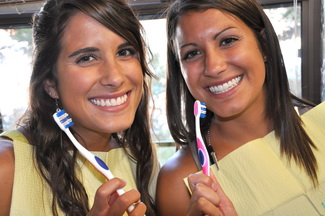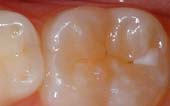



CAMBRA
(Caries
Management by Risk Assessment)
Know your cavity risk...
 As part of your child’s routine care, he or she will be assessed using CAMBRA protocol for his or her risk of developing tooth decay. Individual recommendations to help lower this risk and avoid tooth decay will be made and updated at each recall (cleaning) appointment.
As part of your child’s routine care, he or she will be assessed using CAMBRA protocol for his or her risk of developing tooth decay. Individual recommendations to help lower this risk and avoid tooth decay will be made and updated at each recall (cleaning) appointment.
Care of Teeth...
Good Diet = Healthy Teeth...
 Healthy eating habits lead to healthy teeth. Like the rest of the body, the teeth, bones and the soft tissues of the mouth need a well-balanced diet. Children should eat a variety of foods from the five major food groups. Most snacks that children eat can lead to cavity formation. The more frequently a child snacks, the greater the chance for tooth decay. How long food remains in the mouth also plays a role. For example, hard candy and breath mints stay in the mouth a long time, which cause longer acid attacks on tooth enamel. If your child must snack, choose nutritious foods such as vegetables, low-fat yogurt, and low-fat cheese, which are healthier and better for children’s teeth.
Healthy eating habits lead to healthy teeth. Like the rest of the body, the teeth, bones and the soft tissues of the mouth need a well-balanced diet. Children should eat a variety of foods from the five major food groups. Most snacks that children eat can lead to cavity formation. The more frequently a child snacks, the greater the chance for tooth decay. How long food remains in the mouth also plays a role. For example, hard candy and breath mints stay in the mouth a long time, which cause longer acid attacks on tooth enamel. If your child must snack, choose nutritious foods such as vegetables, low-fat yogurt, and low-fat cheese, which are healthier and better for children’s teeth.
How Dental Decay Happens...
Dental decay is a transmissible bacterial disease caused by certain types of bacteria (mutans streptococci and lactobacilli) that live in your mouth. These bacteria feed on what you eat especially sugars and cooked starch (bread, cereal, crackers and chips). Within a few minutes after you eat or drink, bacteria begin producing acids as a byproduct of their digesting your food. These acids can penetrate your enamel and dissolve away some of the minerals. If the acid attacks are infrequent and of short duration, your saliva can help to repair the damage by neutralizing the acids and supplying minerals and fluoride back into the enamel. However, if you snack frequently, then the tooth mineral loss by attacks of acid is too great and the tooth starts to decay. For this reason, babies should not be allowed to sleep with milk or juice in their bottles. Children are infected by parents, care-givers, siblings and even classmates through saliva transfer. Dental decay is the most common chronic disease of childhood.
Snack and Sip All Day
Risk Decay!
How to Prevent Cavities...
Brush and Floss! Proper oral hygiene removes bacteria and left over food particles that combine to promote tooth decay. For infants, parents should use a wet gauze or thin washcloth to wipe plaque from the teeth and gums. For older children, brush at least twice a day and floss at least once each day.
Eat healthy! Maintain healthy dietary habits avoiding snacking on sugary foods and cooked starches. Avoid soda and sugary sports drinks.
Know your CAMBRA score! Follow your pediatric dentist’s recommendations based on your individual score.

Seal your permanent molars!
Regularly see your pediatric dentist! The American Academy of Pediatric Dentistry recommends visits every six months beginning at your child’s first birthday. Routine visits will start your child on a lifetime of good dental health.
What about fluoride...
 Fluoride is a naturally occurring element found mainly in water. It is also found in most toothpastes, prescribed supplements and in-office fluoride varnish. Topical fluoride aids in the remineralization (repair) of tooth enamel by linking tooth minerals together, making the tooth stronger. It also inhibits the growth of plaque bacteria.
Fluoride is a naturally occurring element found mainly in water. It is also found in most toothpastes, prescribed supplements and in-office fluoride varnish. Topical fluoride aids in the remineralization (repair) of tooth enamel by linking tooth minerals together, making the tooth stronger. It also inhibits the growth of plaque bacteria.
In growing children, ingested fluoride is deposited from the bloodstream into developing teeth making them stronger even before they erupt.
Fluoride supplements might be indicated if the water supply does not contain adequate amounts of fluoride. It is important to look for hidden sources of fluoride in your child’s diet before adding fluoride supplements, especially for children under the age of two. (Hidden sources include powdered concentrate infant formula, soy-based infant formula, infant dry cereals, creamed spinach and infant chicken products.) Decaffeinated teas, white grape juices and juice drinks manufactured in fluoridated cities may also contain significant levels of fluoride.
Seal Out Decay....
 Before Sealant Applied |
 After Sealant Applied |
What about Xylitol....
The American Academy of Pediatric Dentistry (AAPD) recognizes the benefits of xylitol on the oral health of infants, children, adolescents, and persons with special health care needs.
The use of XYLITOL GUM by mothers (2-3 times per day) starting 3 months after delivery and until the child was 2 years old, has proven to reduce cavities up to 70% by the time the child was 5 years old.
Studies using xylitol as either a sugar substitute or a small dietary addition have demonstrated a dramatic reduction in new tooth decay, along with some reversal of existing dental caries. Xylitol provides additional protection that enhances all existing prevention methods. This xylitol effect is long-lasting and possibly permanent. Low decay rates persist even years after the trials have been completed.
Xylitol is widely distributed throughout nature in small amounts. Some of the best sources are fruits, berries, mushrooms, lettuce, hardwoods, and corn cobs. One cup of raspberries contains less than one gram of xylitol.
Studies suggest xylitol intake that consistently produces positive results ranged from 4-20 grams per day, divided into 3-7 consumption periods. Higher results did not result in greater reduction and may lead to diminishing results. Similarly, consumption frequency of less than 3 times per day showed no effect.
Here are a few web-sites where you can find xylitol products:
Epic.
http://www.epicdental.com/
Omni 3M ESPE.
http://solutions.3M.com
Zellies.
www.zellies.com
Spry.
www.sprygum.com
Spiffies.
www.spiffies.com
(Xylitol wipes for infants and toddlers).
Mouth Guards....
 When
a child begins to participate in recreational activities and
organized sports, injuries can occur. A properly fitted mouth guard,
or mouth protector, is an important piece of athletic gear that can
help protect your child’s smile, and should be used during any
activity that could result in a blow to the face or mouth.
When
a child begins to participate in recreational activities and
organized sports, injuries can occur. A properly fitted mouth guard,
or mouth protector, is an important piece of athletic gear that can
help protect your child’s smile, and should be used during any
activity that could result in a blow to the face or mouth.
Mouth guards help prevent broken teeth, and injuries to the lips, tongue, face or jaw. A properly fitted mouth guard will stay in place while your child is wearing it, making it easy for them to talk and breathe.
Ask your pediatric dentist about custom and store-bought mouth protectors.

